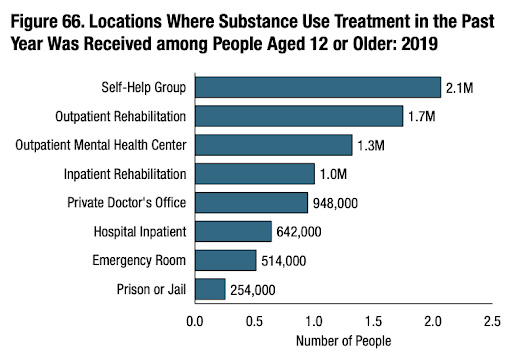Interventions are a great way to help people get started on the path to recovery from alcoholism. However, they are a serious process that can be emotionally draining and requires a lot of preparation. Interventions are performed when you feel like a loved one is heading for a dark path of addiction and want to step in before things get worse.
What is an intervention, and how do you know when to perform it? In this article, we’ll answer these questions.
What Is An Intervention?
An intervention is any effort to help someone struggling with addiction, whether with alcohol, drugs, or other issues. “Intervening” essentially means stepping in and preventing your loved one’s addictive tendencies from worsening, altering their life’s course for the better.
It can be a meeting or series of meetings in which you, and potentially other family members, try to convince them to seek treatment for their substance use disorder (SUD). In this case, alcoholism.
The goal of interventions is to get them into treatment for alcohol addiction and ensure they stay in treatment long enough for it to be effective. You don’t want to shame or scare them into sobriety but rather help them see how their drinking affects them and those around them.
Loved ones can hold an intervention anytime, but it’s most effective before things become too risky—no need to wait for something extreme to happen. If you feel like your loved one is sinking deeper and deeper into addiction, it may be time for an intervention.
Types of interventions
These are four common intervention options for alcoholism, along with information on what they entail, who they are best suited for, and whether professional help is required.
Personal Intervention
The simplest intervention method. It generally involves only the struggling alcoholic and a concerned family member. The concerned family member may or may not seek help from a professional interventionist and then will hold a relatively informal meeting with their loved one.
In the meeting, they will express their concern for how addiction is affecting the struggling alcoholic and the family as a whole.
Classic intervention
A classic intervention aims to direct your loved one into treatment by showing them they have a support system that cares about them. It involves confronting your loved one about their addiction and its impact on those around them.
In this process, family members, friends, and potential romantic partners come together to express their concerns about the damage their addiction causes. Usually, the group or a group member meets with a professional interventionist to prepare for the intervention. During the meeting, the group shares their concerns about their loved one’s addiction and asks for ways to encourage them to seek formal treatment.
The point of a classic intervention is to show the person that they have support in their family, even if they’ve been isolating themselves and avoiding confrontation.
Family intervention
This intervention involves only family members who want to help their loved one get sober. It’s the most common form of intervention for alcoholism.
It’s often part of a more extensive treatment program that includes other forms of therapy and family sessions, where everyone learns how to support their loved one once they leave rehab and start rebuilding their lives.
This kind of intervention helps families come together and support each other as they navigate recovery.
Crisis Intervention
Crisis interventions can help pull an addict out of a dangerous situation. Crisis interventions are reserved for extreme cases where your loved one’s addiction has progressed to the point of risking their life, such as an overdose or an accident while driving under the influence. The priority is to ensure their safety.
Once you have done that, you can begin addressing the larger addiction problem.
This intervention is unplanned, moves quickly, and requires a parent or friend to take direct care of the addict for at least some time to guarantee safety. Once they’ve been cared for and the immediate danger passes, the family may direct them toward the appropriate recovery resources.
What Type Of Intervention Does Your Loved One Need?
The type you choose will depend on many factors, including:
- The severity of their addiction.
- How long they’ve been abusing alcohol.
- The relationship between your loved one and yourself (if you’re not very close, then a formal intervention is likely, not appropriate).
Whether you’re intervening for a friend or a family member, it is essential to remember that forcing them into getting help will likely make things worse. Only they can decide if they want to get better, so make sure you are willing to accept their decision before proceeding further.
Signs It May Be Time For An Intervention
These are tell-tale signs that it may be time for an intervention.
Alcohol Use Is Excessive And Uncontrollable
- Your loved one frequently drinks at unusual times, such as first thing in the morning.
- Their alcohol consumption affects their performance at work, their behavior during family gatherings, or they drink at risky times, like when driving.
- They can’t stop drinking once they have started.
- They’ve failed to reduce alcohol intake before.
They Suffer Alcohol-Related Health Issues
Alcoholism causes many health issues, such as hypertension, heart and liver disease, stroke, and digestive problems. Other, more immediate effects of alcoholism include the following:
- They get sick more often (alcohol weakens your immune system).
- Their cognitive abilities weaken, leading to poor professional and school performance.
- Drowsiness, vomiting, diarrhea, and frequent upset stomachs.
- Headaches.
- Slurred speech.
- Perception, awareness, and coordination issues.
- Hearing and vision issues.
- Breathing difficulties.
- Blackouts from excessive drinking.
Their Drinking Harms Them And Others
If they frequently engage in risky behavior, such as driving under the influence, having unprotected sexual encounters, or starting physical altercations, these are signs that their alcohol abuse is getting out of hand.
Talking To Them Hasn’t Worked So Far
If passing conversations about their excessive alcohol use haven’t worked so far, it may be time to plan and intervene.
How To Stage An Intervention For An Alcoholic?
Interventions can be highly effective for getting someone into treatment, but they’re also intimidating. The following is a general outline of how interventions could go:
- Start sharing your concerns more seriously: start telling them firmly but compassionately that their alcoholism concerns you. Tell them the signs of alcoholism you’ve noticed and try to have open conversations about how they feel about it.
- Enroll the help of people who they love and respect: if you think the situation merits having a big meeting or getting other loved ones to express their concerns, too, you can try to enroll their help for the upcoming intervention.
- Intervene: it may be a good idea to prepare yourself ahead of time by scripting at least some of the essential points. The main message you need to send is that you’re deeply concerned for their well-being. The time and place depend on many factors, but it should be somewhere comfortable where they don’t feel cornered. Not a public spot.
- If nothing else works, give them an ultimatum: it’s never easy, but it may be necessary. They need to know that you will not continue to support them unless they agree to enter treatment. The goal is that they find the lack of support overwhelming and give in to treatment. Treatment doesn’t have to be entirely voluntary to be effective.
- Seek professional help: explore treatment alternatives near you and pick the one that best suits your loved one’s needs.
Treatment Options For Alcoholism
Medication-assisted treatment (MAT)
MAT is the combination of medications and behavioral therapies to provide a complete treatment approach for any substance use disorder. Your loved one may use FDA-approved medications for alcoholism, such as disulfiram, naltrexone, and acamprosate.
Detoxification (“detox”)
Detoxing is the process of eliminating toxins left in the body by excessive alcohol use. It’s usually the first step. One of its main benefits is that your loved one will receive treatment from professionals who know how to manage the inevitable withdrawal when they stop drinking.
Detox often involves medicine use, medical monitoring, and counseling.
Behavioral Therapies
Behavioral therapies help recovering alcoholics develop skills and attitudes that help them avoid addiction by directing them toward healthier lifestyles. The most common behavioral therapies include cognitive-behavioral therapy (CBT) and multidimensional family therapy (MDFT).
Support Groups
Drug and alcohol support groups provide nonprofessional assistance for individuals with similar conditions seeking long-term recovery from substance abuse. Alcoholics Anonymous (AA) is the most popular and widespread support group for alcoholism.
Integrated into a complete recovery program, support groups can positively impact your loved one’s recovery.
Find Help For Loved Ones Struggling With Alcoholism
If you’re worried about alcoholism affecting the life of someone you love, intervening may be an excellent way to help them get better.
The process will be complicated and unpleasant, but if you can make them see that they have a problem, they may choose to seek treatment and take the first steps toward a healthier, more fulfilling life.










